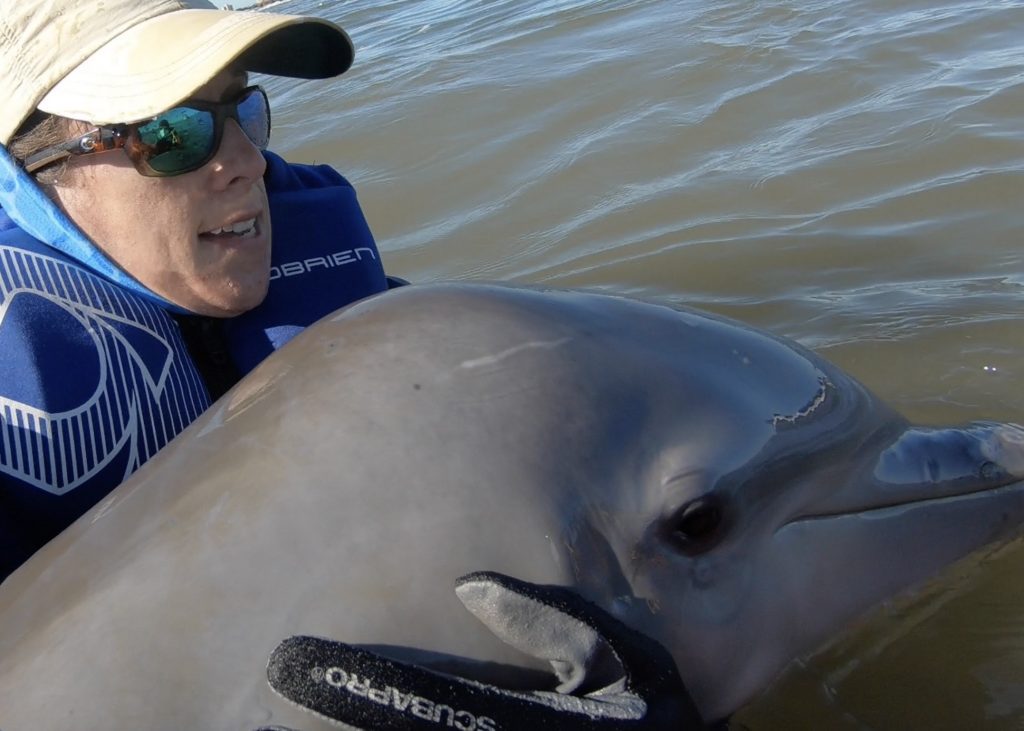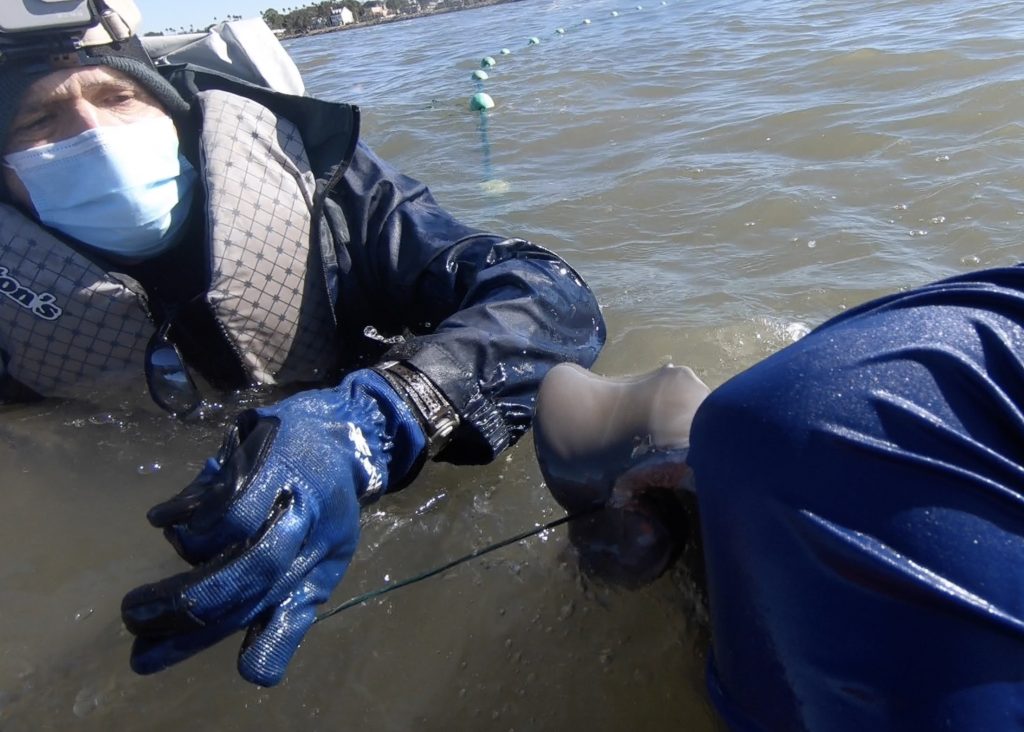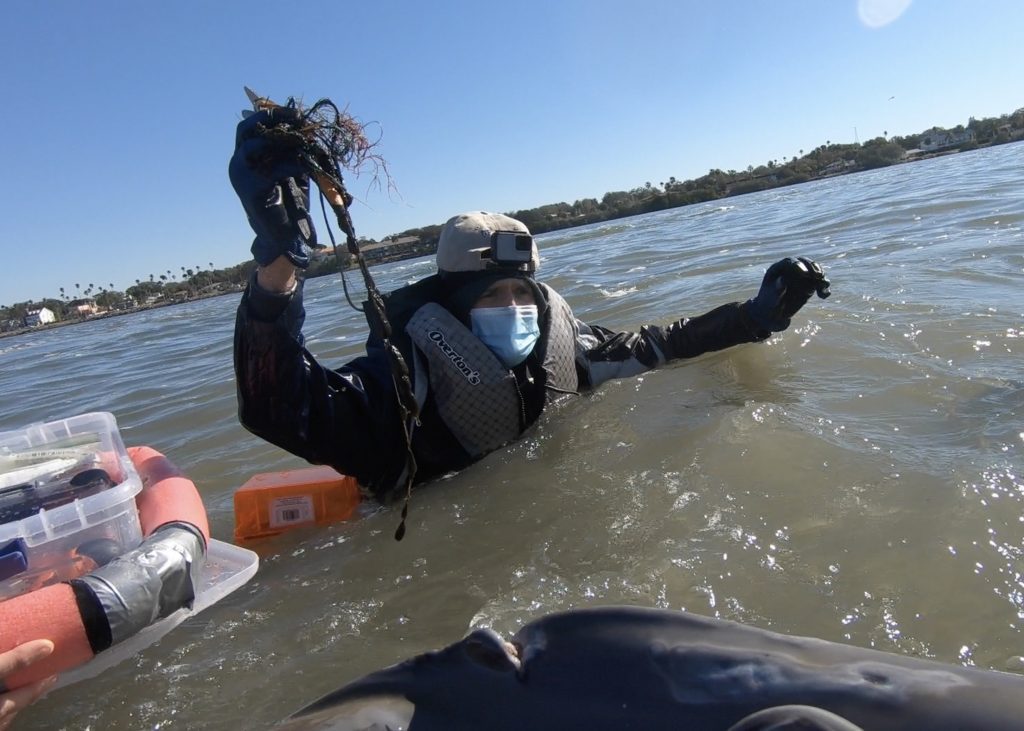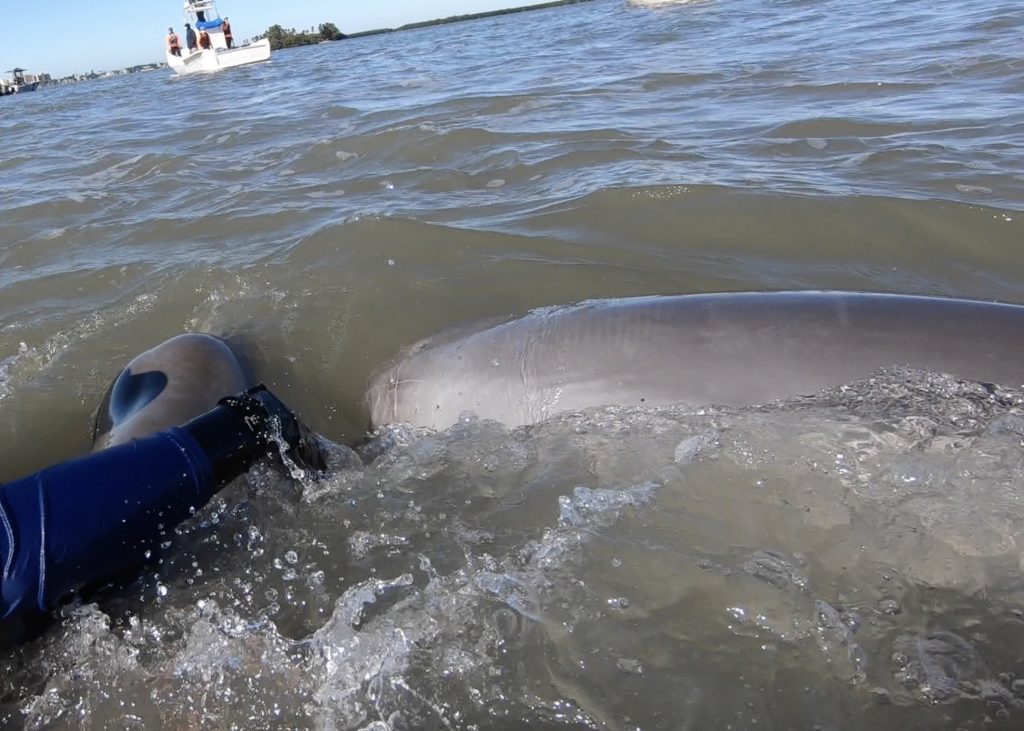
Calf Entangled with Fishing Line
Since early December, Clearwater Marine Aquarium was closely monitoring a bottlenose mother-calf pair after receiving frequent reports of an entanglement. The 7-month-old calf was seen entangled with fishing gear. CMA relayed information and status updates to NOAA as disentanglement attempts must be authorized. Based on the deterioration of the calf’s condition over the past week and after consultation with marine mammal veterinarians and experts, NOAA determined it would be in the calf’s best interest to perform a high-risk catch-and-release intervention.
On Tuesday, January 18, 2022, a team of highly experienced marine mammal stranding network responders successfully removed embedded monofilament and fishing gear.

Authorizing a Disentanglement Attempt
Catch-and-release interventions are dangerous for both the dolphin and rescue teams; therefore, these interventions are attempted only as a last resort. Marine mammal experts and veterinarians were concerned that the likelihood of death during a net capture was extremely high for this dolphin due to its young age and debilitating condition. Thus, every effort was made to remove the entangling line remotely, using cutting tools on long-handled poles from a boat. When those efforts did not succeed and the calf’s condition continued to deteriorate, the risk of intervention was determined warranted to help minimize the animal’s suffering and give it the best chance of survival. Marine mammal responders were assembled from throughout Florida with the experience and resources to safely carry out this rescue effort.

Roles in the Stranding Network FAQ
Q: What is the Stranding Network?
A: NOAA Fisheries oversees the Marine Mammal Health and Stranding Response Program (MMHSRP). This national program coordinates emergency response to sick, injured, distressed, or deceased marine mammals. Clearwater Marine Aquarium is a member of the Southeast Stranding Network. NOAA’s Southeast Regional Office oversees, coordinates, and authorizes stranding network responses to marine mammal and sea turtle strandings in the South Atlantic, the Gulf of Mexico, and the U.S. Caribbean. Read more.
Q: Who is in the Stranding Network?
A: The MMHSRP works with volunteer stranding and entanglement networks as well as local, tribal, state, and federal government agencies to coordinate and conduct emergency responses to stranded or entangled marine mammals. The network members provide staff and local response capabilities, independently raising funds to cover the majority of costs. The stranding and entanglement networks also perform a valuable biosurveillance role, as we are often the first to detect threats to marine mammal populations.
Q: How does CMA help?
A: Clearwater Marine Aquarium plays a crucial role in the reporting, data collection, monitoring, communication, and in-the-field assistance to the Southeast Stranding Network. The information we provide to NOAA and its partners are shared with a panel of marine mammal veterinarians and experts who determine the best course of action that will result in the animal’s best chance for survival.
Q: Why can’t CMA disentangle marine mammals on their own?
A: Only NOAA holds the authorization to determine when an intervention is to take place. Interfering with wild animals are dangerous for both the rescue personnel and the animal as the stress caused during an intervention can cause the animal’s death. CMA relies on the collective knowledge from a team of marine mammal experts and veterinarians to ensure any animal’s best chance of survival.
Q: When does NOAA authorize a disentanglement attempt?
A: A disentanglement attempt is warranted when the risk of intervention is determined by a panel of marine mammal and veterinary experts to provide the best chance of survival for the animal versus non-intervention. Catch-and-release interventions are dangerous for both the rescue personnel and the dolphin and are conducted only as a measure of last resort. Continuous monitoring of an individual is critical as the animal’s situation can change over time and reassessments may cause for different recommended courses of action for survival.
Q: How can I help?
A: If you see an injured, entangled, or dead dolphin, please call the Southeast Region Stranding Network hotline at 1-877-WHALE HELP (1-877-942-5343). Take as many photos and videos as possible, and make note of your GPS coordinates. Be sure to give the animal at least 50 feet to avoid adding any stress to the individual

Thanks to our partners, this dolphin calf was given the best chance possible to survive: University of Florida College of Veterinary Medicine, Mote Marine Laboratory & Aquarium, SeaWorld, Florida Fish & Wildlife Conservation Commission, NOAA Fisheries, and Sarasota Dolphin Research Program.
This rescue effort was conducted under MMPA Permit No: 18786-06.
How You Can Help Protect Wild Dolphins
There are a number of things you can do to help prevent injuries to bottlenose dolphins:
- Don’t cast nets or fishing line towards dolphins, especially if they are engaged in feeding activities
- Never feed wild dolphins – it is illegal and teaches dolphins to beg people for food, drawing them dangerously close to fishing gear and boat propellers. Learn more at, www.dontfeedwilddolphins.org
- Observe wild dolphins from safe distances of at least 50 yards whenever possible
- Avoid touching, swimming, or otherwise closely interacting with wild dolphins, even if they approach you
- Reel in your fishing line when dolphins are near to prevent interactions and entanglement in fishing gear
- Inspect your fishing gear often to avoid unwanted line breaks – even small amounts of gear in the water can be harmful to dolphins if entangled or ingested
- Place all broken or used fishing line in a Monofilament Fishing Line Recycling Bin or a lidded trash can. Local fishing line recycling bins can be found at FWC’s Monofilament Recovery and Recycling website.
If you come across any stranded or distressed dolphins, please call CMA (or your local wildlife rescue organization) right away before intervening. This includes touching, moving, or interacting with the animal in any way. Call our 24-hour rescue hotline before taking any other action: 727-441-1790 Ext. 1. Lean more about entanglements.